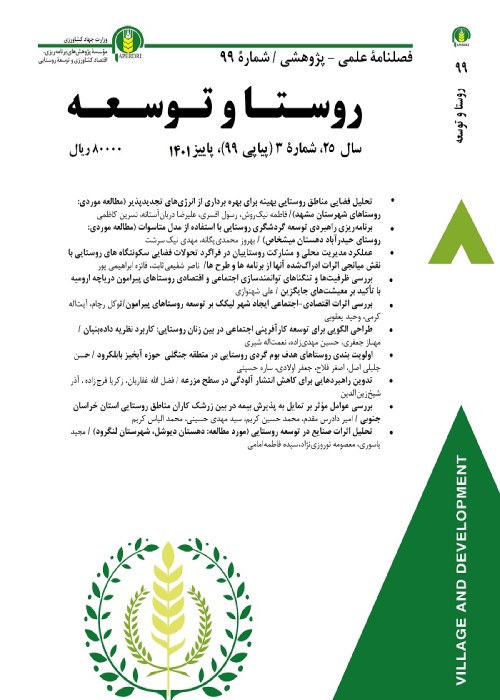An Explanation of Relations between Size of Agricultural Operating Units and Agricultural Intensification Index in Iran with an Emphasis on Rural Community
Author(s):
Abstract:
This paper makes use of results of General Census of Agriculture carried out at the 1960-1993 period as well as crop production reports as its database; and of discriminant analysis techniques, and within groups comparison of operators in order to calculate and analyze the relations between size of agricultural operating units and agricultural intensification index.The results indicate that the level of intensification, yields per hectare, and the return rates in all operating units have increased during the period, and the production of four selected crops including cereals, pulses, industrial plants, and potatoes has reached from 5 712 000 tons in 1960 to 19 858 000 tons in 1993. The indices of the number of operating units, crops cultivated area, proportion of irrigated lands, operating units, proportion of lands under cultivation of labor-intensive crops to total cultivated lands, yields per hectare in family operating units smaller than 10 hectares, are significantly higher than those of large-scale units. These units, with and ownership of 31.5 percent of the lands under cultivation of twenty-one crops studied, accounted for some 50 percent production of these crops and 70 percent production of the selected six labor-intensive crops at 1992-93 crop year. In addition, yields per hectare of nineteen crops in units smaller than 10 hectares were over 5.5 tons and in units of larger than 10 hectares were less than 3 tons. Besides, there were less than 20 percent of the fallow lands in the units smaller than 10 hectares and 42 percent in the units larger than 50 hectares. A reverse correlation between the size of operating units and the factor of agricultural intensification, shown also significant while environmental, natural, spatial, and technical variables are controlled, is mainly influenced by a coordinated management, an experience of indigenous knowledge with a cultivation history of over thousands of years, lower over-head costs, adaptability to environmental changes, higher incentives, adoption of inventions, and duties conducted by members of the family units compared to the large-scale units.
Keywords:
Language:
Persian
Published:
Journal of Village and Development, Volume:9 Issue: 1, 2006
Page:
21
magiran.com/p356178
دانلود و مطالعه متن این مقاله با یکی از روشهای زیر امکان پذیر است:
اشتراک شخصی
با عضویت و پرداخت آنلاین حق اشتراک یکساله به مبلغ 1,390,000ريال میتوانید 70 عنوان مطلب دانلود کنید!
اشتراک سازمانی
به کتابخانه دانشگاه یا محل کار خود پیشنهاد کنید تا اشتراک سازمانی این پایگاه را برای دسترسی نامحدود همه کاربران به متن مطالب تهیه نمایند!
توجه!
- حق عضویت دریافتی صرف حمایت از نشریات عضو و نگهداری، تکمیل و توسعه مگیران میشود.
- پرداخت حق اشتراک و دانلود مقالات اجازه بازنشر آن در سایر رسانههای چاپی و دیجیتال را به کاربر نمیدهد.
In order to view content subscription is required
Personal subscription
Subscribe magiran.com for 70 € euros via PayPal and download 70 articles during a year.
Organization subscription
Please contact us to subscribe your university or library for unlimited access!


